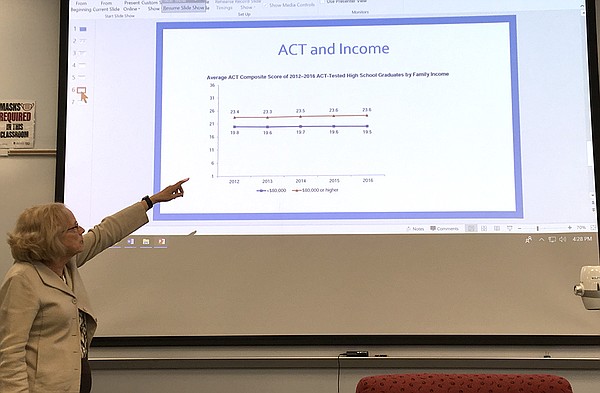Senior Associate Vice President for Enrollment Management Katie Lynch is on the front lines of increasing student enrollment for SF State.
SF State Associate Provost for Sutee Institutional Analysis Sujitparapitaya, received an email from Lynch on April 5 encouraging faculty, students, and alumni to help SF State recruit new students over the phone.
According to Sujitparaitaya, the goal is to help potential students overcome barriers that might prevent them from enrolling.
“We are reaching out to students for student registration services,” Sujitparapitaya said. “That’s why we’re volunteering to call and contact students to let them know that we are strategic communicators who will help bridge the gap and provide information to help them resolve the issues preventing them from enrolling. .”
From fall 2019 to fall 2021, new student enrollment at SF State is down 31%, and Lynch predicts transfer student enrollment next semester will decline, representing the majority of the student body.
Lynch said transfer student enrollment rates are lower than last year.
“We’re seeing an increase in the number of freshmen who accepted their offer of admission and we’re seeing a decrease in transfers who accepted their offer of admission,” Lynch said. “The transfer populations of our major power transfer institutions have been declining over the past two years, so there are fewer community college students to transfer to us.”
They reached over 6,100 potential students through cold calls, professors, alumni and retirees.
Krystalyn Green, an SF State junior, was shocked that the university called for students to enroll.
“I don’t remember talking to any SF State alumni,” Green said. “Most of my interactions with elders have been very short, so I believe [alumni] should get the chance to talk to current students at the school.
Green said if students had more opportunities to talk to alumni, students might have a better perspective on how to navigate college life.
“If a former student can sit down with a new student and be realistic about the school’s values and academic culture, it could help that new student feel a lot better,” Green said. “They need to know what they’re getting into so I think phone calls are a good idea.”
First, Lynch said they plan to continue calling students until May 1, when the decision is made to accept offers of admission. But then she chose to extend the admissions deadline to June 1, to accommodate student needs.
“We’re giving students more time to accept their offer of admission,” Lynch said. “We supplement that with things like visits to our local community colleges so we can be there in person for them to accept their admissions and offer answers to any questions they have.”
Lynch said this method of undergraduate recruiting is used as an effort to meet students and families where they are instead of relying on them to reach out.
Prior to this implementation, SF State President Lynn Mahoney sent out a school-wide message inviting members of the campus community to attend a series of meetings on behalf of the strategic planning of the university, of which she is president.
From Feb. 2 through March 3, members of the SF State community as well as the Strategic Planning Committee met and voiced their opinions on panning efforts that will inform the university’s priorities for the five to next 10 years. These sessions consisted of in-depth, interactive three-hour workshops and 90-minute focus group sessions.
“We have embarked on a strategic planning process that will continue through early summer 2022,” Mahoney said in a post.
Updated data regarding SF State students and faculty was revealed at the event.
Jamillah Moore, SF State’s vice president for student affairs and enrollment management, thinks this issue will have a lasting impact.
“I think it’s just going to have a lasting impact on not just the state of SF, but higher education in general,” Moore said. “That’s really what’s happening as a result of the pandemic nationwide.”
Additionally, Lynch believes the decline has a direct correlation to declining high school graduation rates in California as well as adults choosing not to attend college after graduation.
“Generally speaking, there are fewer college-aged students in our closest areas,” Lynch said. “So a shift in demographics has resulted in fewer students attending college, as well as declining enrollment at many of our community food colleges.”
From fall 2019 to fall 2020, undergraduate enrollment rates decreased by 7.5%. Additionally, from fall 2020 to fall 2021, undergraduate enrollment rates decreased by 5.3%, showing an improvement of approximately 2.2%.
Lynch thinks community college rates in the SF State area could also be attributed to our declining enrollment rates.
“More than half of our students each year are traditionally transfer students, as our community college partners have seen declining enrollment,” Lynch said. “I think that has also translated for us to a decline in transfer student enrollment in particular.”
But as enrollment dwindles, so does CSU’s budget.
These data are based on estimates and not on final amounts linked to the financial statements.
According to data from the SF State Strategic Planning Committee, SF State’s enrollment rates are down about 10 percent.
As for the state allocation through the CSU, it fell by 5% and continues to do so.
SF State failed to meet its first funding goal and suffered a base funding cut of $16.9 million. The next funding goal called for a base funding reduction of $20.3 million, and the third was not met, resulting in a reduction in the university’s base funding of $26.3 million.
The latest funding goal also fell short, and SF State saw the largest base funding reduction on record, approximately $35.6 million. These budget cuts are linked to the decline in school enrollment rates.




